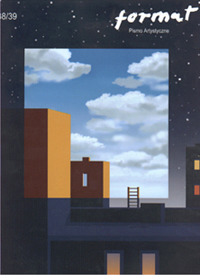Centrum jest wszędzie i nigdzie
The Centre is Everywhere, and Nowhere
Author(s): Andrzej SajSubject(s): Fine Arts / Performing Arts
Published by: Akademia Sztuk Pięknych im. Eugeniusza Gepperta we Wrocławiu
Keywords: art biennial “Peripheries become the Centre; the art of peripheries; political changes in Eastern and Central Europe;
Summary/Abstract: Ten years ago, I added a subtitle to an article on the exhibition of pictures by Greek artists. I wrote that it was “the art of peripheries”, and I was criticised by its author. As magazine editor, I wanted to suggest what I thought about Greek art. I believed that “off-centre” art was more original than uniform installations, videos and objects with postmodernist quotations and anti-consumptionist references which often are shown in recognised cultural centres in Europe. I believed, too, that “off-centre” art was different because of regional influences, connected with local interests and problems. I thought that “peripheral art” was not a negative term, and, that such art was the chance for artistic development in general. I didn’t add any pejorative accent to my statement. Nevertheless, my critics were merciless. They had an opportunity, though, to re-consider their opinion when the National Museum in Prague and the Flash Art Magazine organised a new art biennial entitled “Peripheries become the Centre”. The organisers of the show suggested that off-centre art should be reevaluated and it should be given its proper status. The biennial was the result of better art promotion efforts in Central and Eastern Europe. The trend is connected with political changes in Eastern and Central Europe which guarantee freedom and economic development. Also, regional differences become less significant because of globalisation. Globalisation contributes to the homogenisation of cultural and social aspirations, the growing role of mass media and information networks. Rich countries of Europe and America produce cultural models which influence other cultures. New biennial has broader artistic horizons. It refers to the tendencies which were revealed during the 49th and 50th biennial exhibitions in Venice and the 11th Documenta show in Kassel. Unfortunately, East and Central European art was not shown in proper proportions in Venice and Kassel. In Prague, their representation was proportional, although, the organisers concentrated on young Czech artists. The biennials in Prague and Venice were organised in the same period of time. The curators pf the Prague biennial didn’t build their own counter-offer which would compete with Venice, but, rather, they added to what they considered missing in Venice and Kassel. They said that “Peripheries turn the Centre, and the Centre turn Peripheries”, but they should had remembered the story written by Borges. He wrote that “when the centre is everywhere, it is nowhere”.
Journal: Format - Pismo artystyczne
- Issue Year: 43/2003
- Issue No: 03+04
- Page Range: 015-017
- Page Count: 3
- Language: Polish

